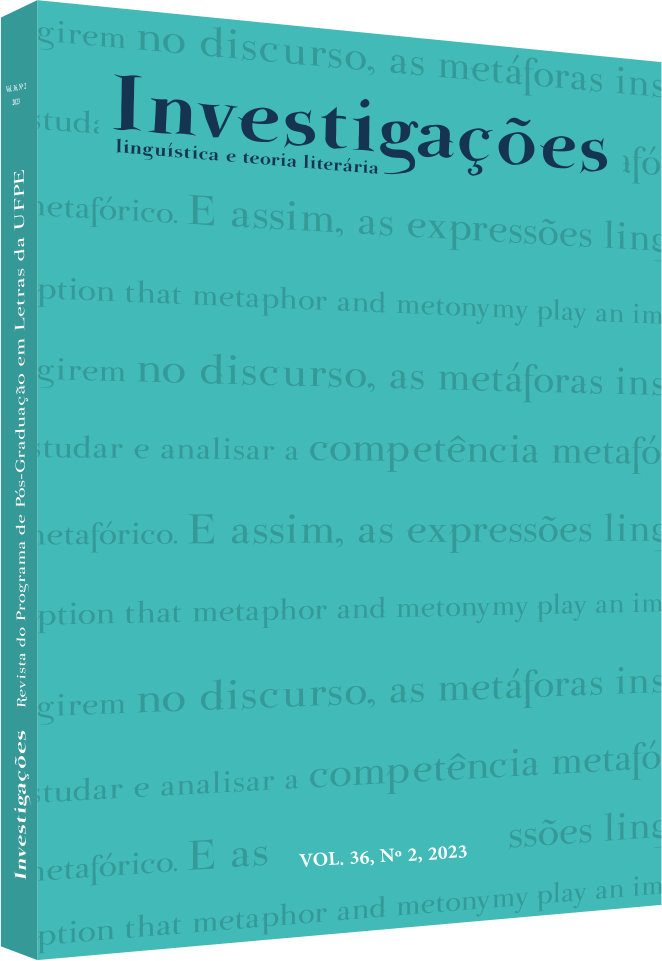Las extensiones semánticas de las onomatopeyas japonesas: metáforas verbales y pictóricas
DOI:
https://doi.org/10.51359/2175-294x.2023.257903Palabras clave:
onomatopeyas, metáfora conceptual, metáfora pictórica, mangaResumen
Este artículo se propone presentar una visión general de aspectos de las onomatopeyas japonesas, presentes en el manga, así como el análisis de sus extensiones semáticas surgidas a través de la metáfora conceptual (Lokoff y Johnson, 1980). Tomoda (1984) demostró el caracter más abstracto que la onomatopeya puede presentar en determinados contextos discursivos-verbales, sin embargo, entendemos que además de la modalidad antes mencionada, las metáforas pictóricas (Forceville, 1996), desempeñan un papel fundamental en el enriquecimiento semántico. En ese proceso hay un texto verbal y un término invocado pictóricamente por médio del contexto, proporcionando así una reinterpretación del texto verbal.
Citas
AKITA, Kimi. A Grammar of Sound-Symbolic Words in Japanese: Theoretical Approaches to Iconic and Lexical Properties of Japanese Mimetics. phd dissertation. 2009.
AKITA, Kimi. Constraints on the semantic extension of onomatopoeia. The Public Journal of Semiotics, v. 5, n. 1, p. 21-37, 2013.
AZEVEDO, Wagner. Dicionário de onomatopeias e vocábulos expressivos. Foz do Iguaçu: Editora Moan, 2022.
BOLINGER, DWIGHT L. Word Affinities. American Speech. Duke University Press. 1940.
BÜHLER, Karl. Theory of Language: The representational function of language. Amsterdam: John Benjamins Publishing Co., 2011.
CALDWELL, Joshua. A Corpus Analysis of Japanese mimetics. Lacus Forum 36 [on line]. 2011. Disponível em http://www.lacus.org/volumes/36/103_caldwell_j.pdf
EVANS, Vivyan; GREEN, Melanie. Cognitive Linguistics: an introduction. Edinburgh: University press, 2006.
FORCEVILLE, Charles. Pictorial Metaphor in Advertising. London: Routledge, 1996.
FORCEVILLE, Charles; URIOS-APARISI, Eduardo (editors). Multimodal Metaphor. Berlin: Mouton de Gruyter, 2009.
HINTON, Leanne; NICHOLS, Johanna; OHALA, John J. Sound Symbolism. New York. Cambridge: University Press, 2006.
INOSE, Hiroko. Translating Japanese Onomatopoeia and Mimetic Words in Manga into Spanish and English. Conference paper, 2007
JOHNSON, Mark. The body in the mind. Chicago: The university of Chicago press, 1987.
LUYTEN, S. M. B. Onomatopeias e mimesis no mangá: a estética do som. Revista USP, São Paulo, n. 52, p. 176-188, 2001-2002.
KÖVECSES, Zoltán. Metaphor: a practical introduction. Oxford: Oxford University Press, 2010.
LAKOFF, George; JOHNSON, Mark. Metaphor we live by. The University of Chicago, 1980.
LAKOFF, G.; JOHNSON, M. Philosophy in the flesh: the embodied mind and its challenge to western thought. New York: Basic Books, 1999.
LOUIS, Thomas; ITO, Tommy. Samurai: The code of the warrior. Nova York: Sterling Publishing Co, 2008.
MARTELOTTA, Mário Eduardo et al. Manual de linguística. São Paulo: Contexto, 2011.
NÖTH, Winfried. Handbook of Semiotics. Bloomington and Indianapolis: Indiana University Press,1990.
OKUMURA, Maki; KABUCHI, Yuko. Nihongo Tango Doriru: Giongo Gitaigo. Shizenna Nihongo O Mi Ni Tsukeyo Motto Hanaseru Motto Tsukaeru. Tóquio: Ask, 2007.
PEIRCE, Charles S. Semiótica. 4. ed. São Paulo: Perspectiva, 2010.
PLATÃO. Crátilo: ou sobre a correção dos nomes. São Paulo: Paulus Editora, 2014.
SAUSSURE, Ferdinand de. Curso de linguística geral. São Paulo: Cultrix, 2006.
SOBRINO, Paula Pérez. Multimodal metaphor and metonymy in advertising. Amsterdam/Philadelphia: John Benjamins, 2017.
TAKAHASHI, Márcia Hitomi. Tradução do conto Atravessando a Neve, de Miyazawa Kenj: alguns aspectos. Estudos Japoneses, n. 27, 2007.
TOMODA, Shizuko. Onomatopoeia and Metaphor. The University of Arizona. Tucson: University of Arizona Linguistics Circel,1984.
TSOI, W. C. Thomas; CHUNG H. W. Clara. Characteristics of Onomatopoeia. LIN1001: Discovering Linguistics, 2004.
VERDENIUS, W.J. Mimesis: Plato’s doctrine of artistic imitation and its meaning to us. Leiden: Brill, 1949.
YAMAMOTO, H. Sugu Ni Tsukaeru Jissen Nihongo Shirīzu 1 — Oto To Imēji De Tanoshiku Oboeru: Giseigo-Gitaigo (ShōChūkyū) [Practical Japanese Workbooks 1—Onomatopoeia: Elementary/ Intermediate]. Tokyo: Senmon Kyōiku Shuppan,1993.
YECIES, Brian; SHIM, Ae-Gyung. South Korea’s webtooniverse and the digital comic revolution. Lanham: Rowman & Littlefield publishing group, 2021.
Descargas
Publicado
Cómo citar
Número
Sección
Licencia
Derechos de autor 2024 Silvio Domingues dos Santos

Esta obra está bajo una licencia internacional Creative Commons Atribución 4.0.
Autores que publicam na Revista Investigações concordam com os seguintes termos:
Autores mantêm os direitos autorais e concedem à revista o direito de primeira publicação, com o trabalho simultaneamente licenciado sob a licença Creative Commons Atribuição 4.0 Internacional (CC BY 4.0) que permite o compartilhamento do trabalho com reconhecimento da autoria e publicação inicial nesta revista.
Autores têm autorização para assumir contratos adicionais separadamente, para distribuição não-exclusiva da versão do trabalho publicada nesta revista (exemplo: depositar em repositório institucional ou publicar como capítulo de livro), com reconhecimento de autoria e publicação inicial nesta revista.
Qualquer usuário tem direito de:
Compartilhar — copiar e redistribuir o material em qualquer suporte ou formato para qualquer fim, mesmo que comercial.
Adaptar — remixar, transformar e criar a partir do material para qualquer fim, mesmo que comercial.
O licenciante não pode revogar estes direitos desde que você respeite os termos da licença.
De acordo com os termos seguintes:
Atribuição — Você deve dar o crédito apropriado, prover um link para a licença e indicar se mudanças foram feitas. Você deve fazê-lo em qualquer circunstância razoável, mas de nenhuma maneira que sugira que o licenciante apoia você ou o seu uso.
Sem restrições adicionais — Você não pode aplicar termos jurídicos ou medidas de caráter tecnológico que restrinjam legalmente outros de fazerem algo que a licença permita.

